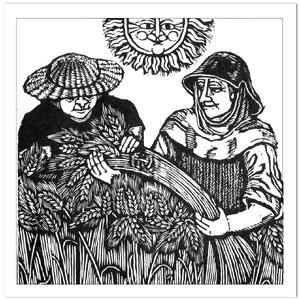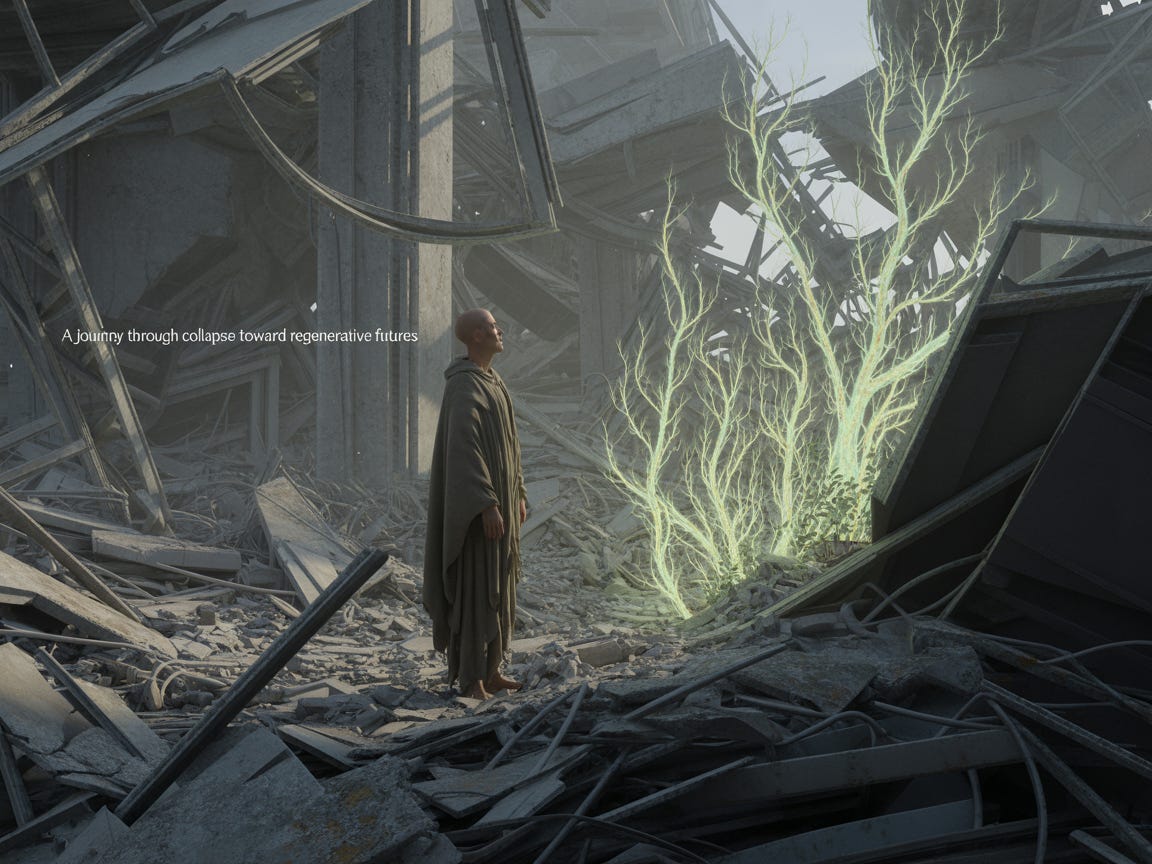Lammas Day - the first day of August, once observed as the first harvest festival, during which bread baked from the first crop of wheat was blessed. Lammas means "Mass of the Bread", although in pre-Christian times it was called Lughnasadh (Day of Lugh) a traditional celebration of the Celtic Sun God Lugh. As such, the celebration often traditionally included many games and feats of strength, among them the famous Highland Games, which included sports such as log throwing and sword dancing.
The Wicker Man was traditionally related to the Lammas ceremonies - he represented the God who dies and is ever reborn, the eternal "Green Man" in the next year, next growing season, next cycle, next turning, the lover of the Goddess, the Earth Mother. This ancient and ubiquitous symbol of the sacrificed and resurrected God, related to both the Sun and the Grain is found "resurrected" in numerous myths and religions, among them Osiris, the Green Man, Dummuzi the shepherd, even in Christianity where it is found in the death and ressurection of the Christ - born at the Winter Solstice (often called the "return of the light"), sacrificed, and then reborn, appropriately at the time of the Spring Equinox.
In contemporary neo-Pagan culture the effigy is often created and loaded with offerings of food, flowers and prayers on paper before it is burned - this tradition is sometimes carried on indirectly in the creation of sculptures that are burned in the closing bonfires of Starwood Festival on the East Coast.
 |
| Starwood Bonfire |
Fields of listening, whispering corn
Ripen in the heavy air
Lugh the Golden dancing forth,
Leaves and sheaves in his wild hair.
In perfect circles bow the stalks,
Mark the path where great Lugh walks,
Mark days and seasons, round they go,
As above, so below.
All that dies shall be reborn
All that dies shall be reborn
Rev. Raven Spirit 2002
John Barleycorn Must Die is a traditional English song very much related to early traditions of Lammas and Lughnasadh - records of its origins go back as far as the 1300s, and it is probably much older than that. Over time, many variations have arisen, and the Scottish poet Robert Burns wrote his own version of the story. In the 70's, John Renbourne, Traffic, and Steeleye Span popularized the song, along with many folk artists during the Folk Revival of the 60's and 70's.
"In English folklore, the folksong representing John Barleycorn as the crop of barley corresponds to the same cyclic nature of planting, growing, harvesting, death and rebirth. Sir James Frazer cites this tale of John Barleycorn in The Golden Bough as proof that there was a Pagan cult in England that worshiped a god of vegetation, who was then sacrificed to bring fertility to the fields. It is tempting to see in this echoes of human sacrifice as portrayed in The Wicker Man film (1973), but that is not really what this time is about. Whilst there was a Celtic ritual of weaving the last sheaf of corn to be harvested into a wicker-like man or woman, it was believed that the Sun 's spirit was trapped in the grain and needed to be set free by fire and so the effigy was burned........In other regions a corn dolly is made of plaited straw from this sheaf, carried to a place of honor at the celebrations and kept until the following spring for good luck."
It's interesting that in Robert Burn's poem, there are "three kings", similar to the kings from the east in the Nativity story. Early Christians who came to the British Isles (and elsewhere) often absorbed native pagan mythologies and traditional rituals into Christian theology/mything. The evolution of the Story of Christ is full of such imagery in order to help the natives accept Christianity: it is very unlikely that Jesus was actually born on the Winter Solstice, for example. Certainly John Barleycorn shares with the Christ Story the ancient, ubiquitous theme of the death and rebirth of the sacrificed agricultural King.
 I am a great admirer of the wisdom traditions of Christianity, but I also believe it is necessary to separate the spiritual teachings of Christianity from the mingling (and literalization) of earlier mythologies absorbed, and often changed or even demonized, throughout the very long development of the Christian Church.
I am a great admirer of the wisdom traditions of Christianity, but I also believe it is necessary to separate the spiritual teachings of Christianity from the mingling (and literalization) of earlier mythologies absorbed, and often changed or even demonized, throughout the very long development of the Christian Church.
John Barleycorn
by Robert BurnsThere was three kings into the east,
Three kings both great and high,
And they hae sworn a solemn oath
John Barleycorn should die.
They took a plough and plough'd him down,
Put clods upon his head,
And they hae sworn a solemn oath
John Barleycorn was dead.
But the cheerful Spring came kindly on,
And show'rs began to fall;
John Barleycorn got up again,
And sore surpris'd them all.
The sultry suns of Summer came,
And he grew thick and strong,
His head weel arm'd wi' pointed spears,
That no one should him wrong.
The sober Autumn enter'd mild,
When he grew wan and pale;
His bending joints and drooping head
Show'd he began to fail.
His coulour sicken'd more and more,
He faded into age;
And then his enemies began
To show their deadly rage.
They've taen a weapon, long and sharp,
And cut him by the knee;
Then ty'd him fast upon a cart,
Like a rogue for forgerie.
They laid him down upon his back,
And cudgell'd him full sore;
They hung him up before the storm,
And turn'd him o'er and o'er.
They filled up a darksome pit
With water to the brim,
They heaved in John Barleycorn,
There let him sink or swim.
They laid him out upon the floor,
To work him farther woe,
And still, as signs of life appear'd,
They toss'd him to and fro.
They wasted, o'er a scorching flame,
The marrow of his bones;
But a Miller us'd him worst of all,
For he crush'd him between two stones.
And they hae taen his very heart's blood,
And drank it round and round;
And still the more and more they drank,
Their joy did more abound.
John Barleycorn was a hero bold,
Of noble enterprise,
For if you do but taste his blood,
'Twill make your courage rise.
'Twill make a man forget his woe;
'Twill heighten all his joy:
'Twill make the widow's heart to sing,
Tho' the tear were in her eye.
Then let us toast John Barleycorn,
Each man a glass in hand;
And may his great posterity
Ne'er fail in old Scotland!
And here is Steeleye Span to tell the tale!



















.jpg)
